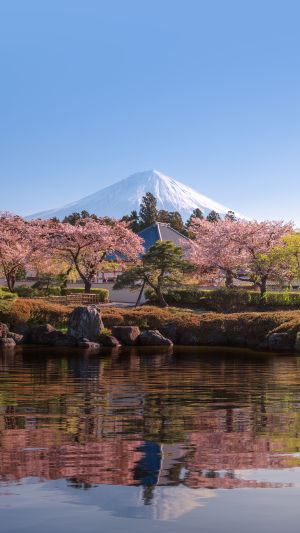Mount Fuji is famous as Japan’s iconic peak.
Towering at 3,776 meters (12,389 feet), this majestic volcano attracts millions of visitors each year.
<b>Getting There:</b>
- By Train: The most popular route is to take the JR Tōkai Line from Tokyo to Otsuki Station, then transfer to the Fujikyu Railway to reach Kawaguchiko Station. The total journey takes about 2.5 to 3 hours and costs around $30.
- By Bus: Direct buses from Tokyo to the Fuji Five Lakes area are available, taking approximately 2.5 hours and costing around $25. This is a convenient option if you prefer not to transfer.
- By Car: Renting a car gives you the flexibility to explore the surrounding areas at your own pace. The drive from Tokyo takes about 2 hours, and parking is available at various locations around the mountain.
<b>Best Time to Visit:</b>
The ideal time to visit Mount Fuji is during the climbing season, which runs from early July to early September. During this period, the weather is generally mild, and the trails are open. However, if you’re not interested in climbing, spring (March to May) and autumn (September to November) offer stunning views of cherry blossoms and fall foliage, respectively.
<b># Exploring the Area:</b> Hiking Mount Fuji
For those looking to conquer the peak, hiking Mount Fuji is a must-do experience. The most popular route is the Yoshida Trail, which starts from the 5th Station. Here’s what to expect:
- Difficulty: Moderate to challenging, depending on your fitness level.
- Duration: The ascent takes about 5-7 hours, while the descent takes around 3-5 hours.
- Cost: A climbing permit is not required, but a fee of approximately $10 is charged at the 5th Station for facilities and maintenance.
Scenic Spots:
If hiking isn’t on your agenda, there are plenty of other ways to enjoy the beauty of Mount Fuji:
- Lake Kawaguchi: One of the Fuji Five Lakes, Lake Kawaguchi offers stunning views of the mountain, especially during sunrise and sunset. Rent a paddleboat or simply stroll along the lakeside for a relaxing experience.
- Chureito Pagoda: This five-story pagoda is a popular photography spot, especially during cherry blossom season. The view of Mount Fuji framed by cherry blossoms is truly breathtaking.
- Fujisan World Heritage Center: Learn about the cultural significance of Mount Fuji at this informative center. Admission is free, and it’s a great way to deepen your understanding of the area.
<b>Local Cuisine:</b>
No trip to Mount Fuji is complete without indulging in the local cuisine. Here are a few dishes to try:
- Hōtō: A hearty noodle soup made with flat udon noodles, seasonal vegetables, and miso broth. Expect to pay around $10 for a bowl.
- Yoshida Udon: Another local specialty, these thick noodles are served in a savory broth and topped with various ingredients. A meal typically costs about $8 to $12.
- Freshwater Fish: The lakes around Mount Fuji are home to delicious fish, often grilled or served as sashimi. Prices vary, but expect to spend around $15 for a fish dish.
<b> Accommodation Options:</b>
From traditional ryokans to modern hotels, there are plenty of accommodation options near Mount Fuji:
- Ryokan: Experience traditional Japanese hospitality at a ryokan, where you can enjoy tatami mat rooms and kaiseki meals. Prices range from $100 to $300 per night.
- Hotels: There are various hotels in the Fuji Five Lakes area, with prices ranging from $80 to $200 per night, depending on the amenities.
- Camping: For the adventurous, camping near the lakes is an option. Campsites typically charge around $20 per night.
<b>Cost Summary</b>
Here’s a quick breakdown of estimated costs for a trip to Mount Fuji:
- Transportation: $25 to $30 (one way)
- Meals: $30 to $50 per day
- Accommodation: $80 to $300 per night
- Activities: $10 for scenic spots and hiking fees
<b>Conclusion:</b>
Mount Fuji is a destination that promises unforgettable experiences, whether you’re scaling its heights or simply enjoying the view from below. With its stunning landscapes, rich culture, and delicious cuisine, it’s no wonder that this iconic mountain is a must-visit for travelers to Japan. So pack your bags, grab your camera, and get ready to create memories that will last a lifetime!





